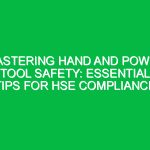In the realm of Health Safety and Environment (HSE), the management of silica dust stands out as a critical concern. Silica, a natural mineral found in the earth’s crust, is a common component of sand, stone, and concrete. When these materials are cut, drilled, or ground, they produce a fine dust known as respirable crystalline silica, which poses significant health risks to workers. This article delves into the hazards associated with silica dust and outlines essential control measures to foster a healthier and safer workplace.
The Hazards of Silica Dust
Understanding the risks associated with silica dust is the first step towards mitigating its impact. When inhaled, the fine particles of respirable crystalline silica can penetrate deep into the lungs, leading to the development of various health issues.
Silicosis
One of the most severe health effects is silicosis, an incurable lung disease that can lead to disability and death. Silicosis results from the accumulation of silica particles in the lungs, causing inflammation and scarring.
Lung Cancer
Exposure to silica dust has also been linked to lung cancer. The International Agency for Research on Cancer (IARC) classifies crystalline silica as a human carcinogen, underscoring the importance of minimizing exposure.
Other Health Risks
Beyond silicosis and lung cancer, silica dust exposure can contribute to chronic obstructive pulmonary disease (COPD), kidney disease, and other respiratory illnesses.
Control Measures for Silica Dust
To protect workers from the hazards of silica dust, it is essential to implement comprehensive control measures. These strategies range from engineering controls to personal protective equipment (PPE), each playing a vital role in reducing exposure.
Engineering Controls
Engineering controls are at the forefront of silica dust management. These measures involve modifying processes or equipment to minimize the generation of dust.
Water Delivery Systems
Using water to suppress dust at the source is an effective strategy. Water delivery systems can be integrated into cutting, grinding, and drilling equipment to reduce dust emissions.
Local Exhaust Ventilation (LEV)
LEV systems capture dust at its source before it disperses into the air. These systems are particularly useful in enclosed or indoor environments where dust can accumulate rapidly.
Work Practices
Adopting safe work practices is crucial in controlling silica dust exposure. This includes planning tasks to minimize dust generation and ensuring proper maintenance and cleaning of work areas and equipment.
Wet Methods
Whenever possible, using wet methods for cutting, drilling, and grinding can significantly reduce dust emissions. This approach involves applying water directly to the work process to capture dust particles.
Regular Maintenance
Regularly cleaning and maintaining tools and equipment can prevent the buildup of silica dust. Vacuuming with HEPA-filtered vacuums or wet sweeping are preferred methods for cleaning up dust.
Personal Protective Equipment (PPE)
When engineering and work practice controls cannot fully eliminate exposure to silica dust, PPE becomes a necessary layer of protection.
Respiratory Protection
Respirators equipped with particulate filters can protect workers from inhaling silica dust. It’s crucial to select the appropriate type of respirator based on the level of exposure and to ensure a proper fit.
Protective Clothing
Wearing protective clothing, such as disposable coveralls, can prevent silica dust from settling on the skin and clothing, reducing the risk of secondary exposure.
Creating a Silica Dust Management Plan
Developing a comprehensive silica dust management plan is essential for any workplace dealing with silica-containing materials. This plan should include risk assessments, exposure monitoring, control measures, training, and health surveillance.
Risk Assessment and Exposure Monitoring
Identifying tasks that generate silica dust and assessing the level of exposure are critical first steps. Exposure monitoring can help determine whether control measures are effective and if additional protections are needed.
Training and Education
Workers and supervisors should receive training on the hazards of silica dust, the importance of control measures, and the correct use of PPE. Education is a powerful tool in preventing exposure and promoting a culture of safety.
Health Surveillance
Regular health checks for workers exposed to silica dust can help detect early signs of silicosis and other related diseases. Early detection is crucial for managing health outcomes and preventing further exposure.
Summary of Key Points
Silica dust poses significant health risks, including silicosis, lung cancer, and other respiratory diseases. To protect workers, it is crucial to implement a combination of engineering controls, work practices, and personal protective equipment. Developing a comprehensive silica dust management plan, including risk assessment, exposure monitoring, training, and health surveillance, is essential for maintaining a healthier workplace. By prioritizing safety measures and fostering a culture of awareness and prevention, employers can significantly reduce the hazards associated with silica dust.
Remember, the health and safety of workers are paramount. Taking proactive steps to control silica dust exposure not only complies with regulatory requirements but also demonstrates a commitment to creating a safer, healthier work environment.


